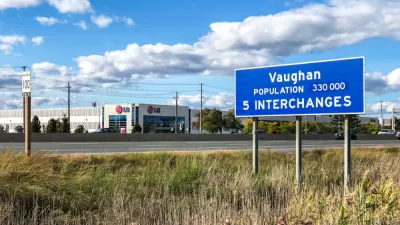Forty-five miles southwest of the Twin Cities sits the exurb of New Prague, a town with state-of-the-art infrastructure but crushing debt. It’s an example of what happens when the “Ponzi scheme” underlying sprawl development comes crumbling down.
Planned at the height of the "exurban boom", New Prague is now feeling the consequences of borrowing $30 million to build a state-of-the-art sewer plant for residents that never came.
In an unsustainable effort to recoup some of its spending, New Prague has repeatedly raised utility rates for its smaller-than-expected number of homeowners and businesses. David Peterson reports, "New Prague raised its rates by 35 percent in 2009, 31 percent in 2010 and 25 percent in 2011 and 2012" but according to the City Administrator Michael Johnson, more jumps are needed to "get those rates to the level needed to cover the debt." This poses a problem when considering that water rates in Minnesota's exurbs are already much higher than in its metro areas, asserts Jeff Freeman, executive director of the Public Facilities Authority.
New Prague is not alone in this situation. Other exurbs such as Avon and North Branch find themselves in the same boat, reports Peterson, strapped for cash and considering draconian measures to payback past borrowing. Like some of these cities, New Prague is now contemplating another budgetary option: long-term debt refinancing. However, "New Prague's financial consultants cautioned that [this would mean] an extra $8.45 million in long-term interest costs for a community of about 7,000," writes Peterson.
For New Prague, there are some signs of hope, however, including a slight resurgence in housing starts, and the announcement of a factory expansion and new jobs. City officials like Johnson still remain cautious, "There's no way to develop any forecast." he says.
FULL STORY: Exurbs built infrastructure, but nobody came to pay for it

Planetizen Federal Action Tracker
A weekly monitor of how Trump’s orders and actions are impacting planners and planning in America.

Maui's Vacation Rental Debate Turns Ugly
Verbal attacks, misinformation campaigns and fistfights plague a high-stakes debate to convert thousands of vacation rentals into long-term housing.

San Francisco Suspends Traffic Calming Amidst Record Deaths
Citing “a challenging fiscal landscape,” the city will cease the program on the heels of 42 traffic deaths, including 24 pedestrians.

Amtrak Rolls Out New Orleans to Alabama “Mardi Gras” Train
The new service will operate morning and evening departures between Mobile and New Orleans.

The Subversive Car-Free Guide to Trump's Great American Road Trip
Car-free ways to access Chicagoland’s best tourist attractions.

San Antonio and Austin are Fusing Into one Massive Megaregion
The region spanning the two central Texas cities is growing fast, posing challenges for local infrastructure and water supplies.
Urban Design for Planners 1: Software Tools
This six-course series explores essential urban design concepts using open source software and equips planners with the tools they need to participate fully in the urban design process.
Planning for Universal Design
Learn the tools for implementing Universal Design in planning regulations.
Heyer Gruel & Associates PA
JM Goldson LLC
Custer County Colorado
City of Camden Redevelopment Agency
City of Astoria
Transportation Research & Education Center (TREC) at Portland State University
Jefferson Parish Government
Camden Redevelopment Agency
City of Claremont





























